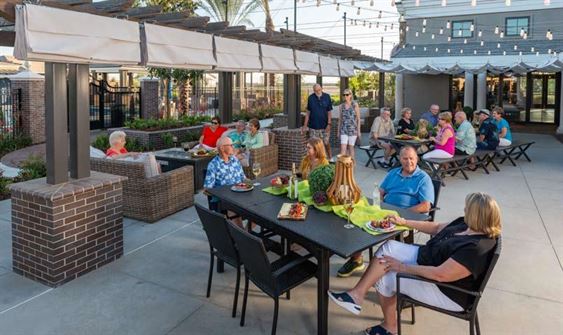by Robert Borges on May 1, 2024
5-minute read
Jump to:
- What Are 55+ Communities?
- A Brief History of 55+ Communities
- What Are the 55+ Community Rules and Regulations?
- Tips for Choosing a 55+ Community
What you'll get from this article: A brief history of 55+ communities and details on the latest regulations, exceptions to the age rule, and tips as you consider a move to a 55+ active adult community.
Thinking about making the move to an age-restricted 55 and over community? You're not alone. It’s estimated that there are more than 76 million baby boomers in the U.S., and many of them are looking for a more suitable living environment as they enter retirement.
Having worked with the nation’s top lifestyle communities since 1996, PCR has spent decades highlighting the wealth of benefits they offer, helping match thousands of homebuyers with their perfect community. From low-maintenance living and social activities to amenities designed for active adults in the country’s most desirable retirement destinations, there’s a lot to love about living in a 55+ community.
But before you pack your bags, there's one key question: who qualifies to live in a 55+ community in 2024? This article dives into the latest regulations, explores exceptions to the age rule, and offers tips as you consider a move to a 55+ active adult community.
What Are 55+ Communities?
As neighborhoods or housing developments that promote "active adult living," 55+ master-planned communities are designed specifically for individuals aged 55 and older. They typically offer amenities and services tailored to the needs and preferences of older adults, like a quieter environment, recreational facilities, walking trails, fitness centers, and coordinated social activities.
Housing options within the communities vary, but often include low- or no-maintenance single-family homes, townhouses, condominiums, or apartments. They cater to pre-retirees and retirees who are looking to downsize from larger homes, simplify things while remaining active and engaged, and enjoy the benefits of living among like-minded individuals.
A Brief History

The concept of 55+ communities traces its roots back to the early 1960s, when developers began recognizing a growing demand among retirees and empty nesters for housing options that better aligned with their stage in life. One of the earliest examples of these communities is Sun City, located in Arizona, which opened its doors in 1960 under the vision of real estate developer Del Webb.
As the preeminent 55+ community, the original Sun City offered a wide array of amenities and recreational facilities customized for the active lifestyle of its residents, including golf courses, swimming pools, and social clubs. Its success sparked a wave of similar developments across the United States. There are now more than 2,000 55+ communities in the U.S.—from a variety of renowned developers.
What Are the 55+ Community Rules and Regulations?
Communities for those aged 55 and above offer a comfortable lifestyle for their residents. But who exactly can live in these communities? What are the policies surrounding children and visitors? While the structure and guidelines may not be too rigid and overbearing, there are rules and requirements all potential 55+ homebuyers should be aware of.
55+ Community Age Restrictions
The Federal Fair Housing Act prohibits discrimination in housing based on various factors, but notably excludes age. This omission allows developers and communities to establish property ownership limitations, cultivating “age-restricted communities.” However, not all communities are exclusively for senior adults. Yes, in some communities all residents must be over 55. But others just require each household to have at least one resident meeting the minimum age threshold, spouses/partners being at least 40, and “children” 18 or older. Because this can vary, it’s best to do your research to get all the specifics and understand HOA bylaws for the communities you’re considering.

- Spouses/Partners: If one resident meets the age requirement, their spouse or partner under 55 can typically live there.
- Family: Some communities allow a certain number of adult children (over 18) to live with a qualifying parent. However, these situations might come with specific rules about occupancy or length of stay.
- Grandchildren: While permanent residency for grandchildren is uncommon, most communities allow them to visit for limited periods.
Are Kids Allowed in 55+ Communities?
In short, no. It's highly unusual to find a retirement community where children can reside full-time. However, this doesn't mean your kids and grandkids can't visit or that you won't encounter children in your 55-plus community. Children are typically welcome as guests, but usually for short-term stays. The rules regarding visiting children differ between communities, but visits commonly range from two weeks to 30 days.
While some communities may have designated areas for children to play, ensuring a balance between relaxation for residents and fun for young visitors, it's not uncommon to see 55+ communities embrace young visitors with intergenerational activites and amenities. These can include things like game rooms, movie nights, concerts, cooking and arts & crafts classes, playgrounds, pools, splash pads, trails to explore, and more.
The 80/20 Rule
The passage of the Housing for Older Persons Act (HOPA) in 1995 included the “80/20 Rule.” It stated that at least 80% of occupied units in an age-restricted community must have a resident aged 55 or older, demonstrating an intent to cater to this demographic. The remaining 20% provides flexibility in certain situations, without lifting the age restrictions. For instance, if a younger resident inherits a home due to the passing of an older occupant, they can often remain under the 20% cushion of this rule.* Keep in mind, though, that most age-restricted retirement communities aim to maintain the minimum age requirement in 100% of households.
*While younger loved ones can inherit your home in a 55 and over community, living there might not be an option. If you plan to leave your property to someone under 55, it's wise to chat with both your lawyer and the community representatives. Together, you can explore potential solutions to ensure your wishes are met and the community guidelines are followed.
Tips for Choosing a 55+ Community

Now you have the basics on who can live in a 55-plus community. If it sounds like a good fit as you contemplate a potential move, just be sure to do your due diligence.
Research the community: Carefully review the community's age restrictions and occupancy rules. Request and read the covenants, conditions, and restrictions (CC&Rs) and homeowners association (HOA) bylaws so you can make an informed decision.
Ask questions: Don't hesitate to ask the community management about any specifics regarding age requirements, exceptions, and guest policies.
Talk to residents: Talking to current residents can give you valuable insights into the community's atmosphere. Schedule site visits or take advantage of commuity Discovery Packages to "test drive" communities before deciding.
Start exploring on PCR: Delve into comprehensive details about amenities, pricing, real estate options, rules, and additional insights to pinpoint the perfect 55 and over community for you!
